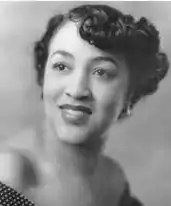Mary Kenner
Mary Beatrice Davidson Kenner (May 17, 1912 – January 13, 2006) was an American inventor most noted for her development of the sanitary belt. Racial discrimination prevented its adoption for thirty years.[1]
Mary Beatrice Davidson Kenner | |
|---|---|
 | |
| Born | 17 May 1912 |
| Died | January 13, 2006 (aged 93) Sibley Memorial Hospital, Washington, D.C., United States |
| Nationality | United States of America |
| Occupation | Florist |
| Known for | inventing |
Background
She was born in North Carolina and came from a family of inventors. Her father, whom she credited for her initial interest in discovery, was Sidney Nathaniel Davidson (June 1890-November 1958).[2] In her lifetime, he patented a clothing press which would fit in suitcases, though he ultimately made no money on the invention.[3] Her father also patented a window washer for trains and invented a stretcher with wheels for ambulances.[1] Her grandfather invented a light signal for trains, though this invention was stolen from him.[1] Her sister, Mildred Davidson Austin Smith (1916–1993), invented and commercially sold board games.[3]
Kenner graduated from high school in 1931. She attended Howard University, although she was unable to finish due to financial difficulties.[4]
Inventions
She invented an adjustable sanitary belt with an inbuilt, moisture-proof napkin pocket. In 1956, she was finally able to save up enough money to get her first patent on it.[3][4] However, the company that first showed interest in her invention, the Sonn-Nap-Pack Company, rejected it after they discovered that she was African American.[5][4][1] Kenner never made any money off of the sanitary belt, because her patent expired and became public domain, allowing it to be manufactured freely.[1]
Between 1956 and 1987 she received five total patents for her household and personal item creations.[6] She shared the patent on the toilet tissue holder with her sister, Mildred Davidson.[7][8] She also held a patent on a back washer that could be mounted on the shower or bathtub wall.[9] This invention was patented in 1987 patent number 4696068.[9] She also patented the carrier attachment for a walker in 1959, after Mildred developed multiple sclerosis.
Personal life
Mary Kenner worked as a professional floral arranger and had four flower shops scattered around the Washington, DC, area.[10][1] She worked in her stores for a total of 23 years.[1] she also had dropped out of college cause of her money. Kenner was married to renowned heavyweight boxer James "Jabbo" Kenner. Together, they lived in McLean, Virginia, near the Kennedy's complex. They were foster parents to five boys.[1]
References
- Hambrick, Arlene (1993). "Biographies of black female scientists and inventors: an interdisciplinary middle school curriculum guide: "What shall I tell my children who are black?"". ScholarWorks@UMass Amherst: 132–144 – via Google Scholar.
- "Mary Beatrice Davidson Kenner". Pioneering Women Herstory. Archived from the original on 4 March 2016. Retrieved 30 April 2015.
- Tsjeng, Zing (2018-03-08). "The Forgotten Black Woman Inventor Who Revolutionized Menstrual Pads". Vice. Retrieved 2020-02-06.
- Laura S. Jeffrey (1 July 2013). Amazing American Inventors of the 20th Century. Enslow Publishing, LLC. ISBN 978-1-4646-1159-9.
- "The Forgotten Black Woman Inventor Who Revolutionized Menstrual Pads". VICE. 2018-03-08. Retrieved 2020-05-07.
- David, Lenwood. "Women Inventors". NCPedia. Retrieved 30 April 2015.
- {{Cite web|url=https://face2faceafrica.com/article/womens-history-month-meet-mary-mildred-davidson-inventors-sanitary-belt-tissue-holder%7Ctitle=[Women’s History Month] Meet Mary and Mildred Davidson, inventors of sanitary belt, tissue holder|date=2018-03-14|website=Faceto /> The patent number was US 4354643, dated October 19, 1982.<ref name="Colorblind Magazine">"Celebrating African American Women Inventors". Colorblind Magazine. Retrieved 30 April 2015.
- Bellis, Mary. "Black History Month - African American Patent Holders - J to K to L". About.com. Retrieved 30 April 2015.
- "Mary B. Kenner Inventions, Patents and Patent Applications - Justia Patents Search". patents.justia.com. Retrieved 2019-03-17.
- Carter Sluby, Patricia. "African American Brilliance" (PDF). NCDCR. Archived from the original (PDF) on 7 June 2013. Retrieved 30 April 2015.
Further reading
- Blashfield, Jean F. (1996) Women inventors. Minneapolis: Capstone Press. Vol. 4, pp. 11–16
- Jeffrey, Laura S. (September 1, 2013) Amazing American Inventors of the 20th Century. Enslow Publishers, pp 29–35
- Sluby, Patricia C. (2004) The Inventive Spirit of African Americans: Patented Ingenuity. Westport, Conn: Praeger, pp 147–150
- Women Inventors. Women Inventors | NCpedia, 2011, www.ncpedia.org/industry/women-inventors.